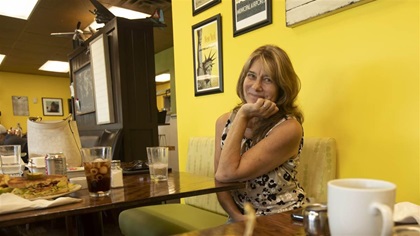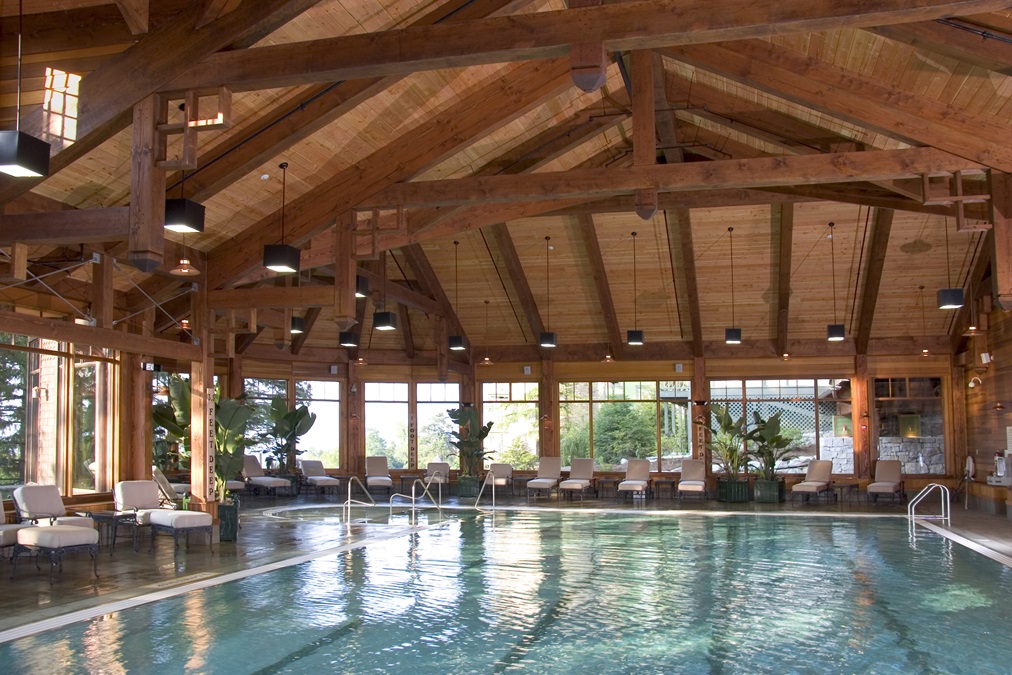Hudson Valley history by air, land, river
Historic sites, modern amenities, many ways to get around
Scenery that inspired a distinctly American art movement and historically significant sites crowded over and around the Hudson River make Poughkeepsie, New York, both a popular stop for those flying the famous VFR corridor past New York City, and a destination that demands more than one visit.
Few regions offer such a multimodal mix of ways to get around. Hudson Valley Regional Airport is a 10-mile drive from one of Poughkeepsie's most popular attractions, the Walkway Over the Hudson, a former railroad bridge turned into a linear park that is used today for walking or bicycling 212 feet above the Hudson River. At the east bank of the river, a 21-story glass elevator connects the walkway to Upper Landing Park and the train station served by Amtrak and Metro North; there is free parking at either end of the 1.28-mile linear park that can challenge the acrophobic among us, though the railings are high and sturdy, and the wide walkway offers some comfort in the middle for those not fond of heights.
"You can get a real appreciation for exactly how majestic the Hudson is," local pilot Mark Nelson said of the former railroad bridge that he recommends as an essential stop (provided the weather is reasonable). The longest bridge in the world when it opened in 1889, the modern park was rebuilt with a concrete deck and opened in October 2009. Bicycle rentals are available, and either end of the park requires no substantial diversion from the driving route from Hudson Valley Regional Airport to Mohonk Mountain House, a destination resort founded in 1869 and designated a National Historic Landmark in 1986.
Activities are available in every season, including cross-country skiing and ice skating in the winter, and golf, hiking, touring the resort's own mountain lake in a rowboat, horseback riding, history tours, and music during the warmer months, to name a few. The highly rated resort is surrounded by 40,000 acres of unspoiled forest and hosts more than 100 special events through the year, in addition to weddings; and it also has restaurants, room service, and a spa.
Rum runners, dynasties
The Hudson Valley (and Poughkeepsie itself) is soaked in history, home to significant places and events dating from the Colonial period and the American Revolution to the Industrial Revolution and modern times. It is where many New York City dwellers seek a countryside escape, and that word "soaked" used with respect to the history here is also to speak of the speakeasies and their suppliers that multiplied around the region during the Prohibition era, a period in U.S. history defined by a constitutional amendment that took effect in 1920 and banned alcohol production and sale, and another in 1933 that ended that ban.
The latter was signed by President Franklin D. Roosevelt, who made his home at Hyde Park, just upriver from Poughkeepsie. Roosevelt's home is operated by the National Park Service and is next to the Franklin D. Roosevelt Presidential Library and Museum that is operated by the National Archives.
Roosevelt's signature on the Cullen-Harrison Act on March 22, 1933, legalized beer with an alcohol content up to 3.2 percent and wine of similar potency; ratification of the Twenty-first Amendment on December 5, 1933, came just over a year after an October 1932 raid by the FBI put legendary New York City mobster and Hudson Valley moonshiner Dutch Shultz out of the bootlegging business.
Roosevelt's presidency became even more historic and significant during World War II, it must be said, though his role in legalizing beer (in particular) is celebrated across the street at Hyde Park Brewing Co., among many purveyors of handcrafted beer and locally sourced cuisine in the region.
Hyde Park is also home to one of the country's most prestigious chef-producing schools, the Culinary Institute of America, a renowned educational institution that offers short courses and other programs for local foodies, along with degree programs that feed the finest kitchens in the country, as well as its own on-campus restaurants. You'll pass the flagship CIA campus and school-run restaurants on the way to see the Roosevelt home and adjacent craft brewery, both of which are a 25-minute drive north from Hudson Valley Regional Airport.
Being in the bootlegging business in the 1920s and early '30s, Schultz preferred to locate his massive stills a little farther out in the New York countryside, on a turkey farm owned by a retired New York City police officer in Pine Plains. Federal agents found there the largest operation of its kind uncovered during Prohibition in Dutchess County, an underground bunker that housed a pair of 2,000-gallon stills. The 1932 raid also netted 10,000 pounds of sugar and 1,000 gallons of Sugar Wash Moonshine, according to Dutch's Spirits, a craft distillery that was featured in Hudson Valley Magazine soon after it opened in 2020.
The 50-minute drive to Dutch's Spirits from Hudson Valley Regional Airport can be reduced to just over 30 minutes if driven from Kingston-Ulster Airport, the 3,100-foot paved runway of which is next to (practically on top of) the Kingston-Rhinecliff Bridge, which added a pedestrian walkway of its own in 2020.
For trip planning purposes, both airports offer fuel and FBO services including car rentals. Hudson Valley Regional Airport spices up its aviation destination appeal with an on-field restaurant operated by proprietor Paula Young.

Young's résumé includes acting on Broadway followed by work as a journalist, later as a senior official in the City of New York Department of Sanitation. She also ran an animal shelter, a wine bar, and, more recently, a onetime Poughkeepsie speakeasy where she established Paula's Public House. Young said she discovered a long-forgotten stash attributed to a gun-toting, cigar-smoking matriarchal character of local lore while replacing an old grease trap, just one of many tales of "bootlegging and buried treasure" that the region has woven into a long story that figures in the American Revolution, and the technology revolution of modern times—IBM developed a host of products over the decades at its campus in Poughkeepsie.
The Hudson River has inspired explorers, painters, and presidents; and Poughkeepsie remains a destination for the jet set. It's a gateway to forest and wilderness and just two hours (driving) north of Manhattan. Visitors at Paula's Runway Café have included members of the Walton family (of Walmart fame) and Amazon founder and billionaire spacefarer Jeff Bezos.
Breakfast and lunch are served at Paula's Runway Café, and dinner at Paula's Public House, which is along one of the available driving routes from the airport and downtown Poughkeepsie.
Dots, dashes
Poughkeepsie is a college town, home to both Vassar College and Marist College, creating regular opportunities for concerts and other events. It is also where you can find the home Samuel Morse built for himself on a historic estate with money that he earned inventing the telegraph, and the code pilots use today to identify navigation aids. Locust Grove Estate overlooks the Hudson River and is run by a nonprofit organization that hosts tours and educational programs. While Morse's furniture is long gone, a permanent exhibit explores his work as an artist and inventor.
This particular dot on the map is a 13-minute dash from the airport, on the way to downtown restaurants and other attractions like the Barrett Art Center, and Bardavon Opera House, the state's longest continually operated theater that hosts film screenings, concerts, and other events.
Scenery by river, rail
If travel by river or rail appeals to you, then Kingston-Ulster Airport north of Poughkeepsie on the west bank of the Hudson River offers slightly shorter drives to a few more multimodal options to consider, such as Hudson River Cruises, which operates a riverboat out of Kingston (with occasional planned stops in Poughkeepsie) in spring, summer, and into the fall foliage season.
The Catskill Mountain Railroad operates excursion trains out of downtown Kingston on tracks winding through hills toward the Catskill Mountains to the north and west of town. The heritage railroad passes the Ashokan Reservoir, a popular destination for outdoor enthusiasts surrounded by trails. The reservoir also supplies nearly half of the fresh drinking water consumed in New York City.
Speaking of railroads and New York, Amtrak serves the Hudson Valley with a variety of trains that run along the east bank of the Hudson, with stops in Poughkeepsie and Rhinecliff. Trains run north and south along the river on regular schedules.
Bard College is also located along the east side of the river, north of the Kingston-Rhinecliff Bridge. Old Rhinebeck Aerodrome, a museum offering living history shows with vintage airplanes in Red Hook, as well as sightseeing rides in a New Standard biplane in season, is seven road miles due east of Kingston-Ulster Airport.
Turning south on River Road toward Rhinecliff, Rhinebeck Village, and the Dutchess County Fairgrounds will soon bring you to the Ferncliff Forest trailhead, where a fire tower along a trail invites the brave to come cap a hike in the woods with a climb to some of the best views around, including the river and mountains beyond.














